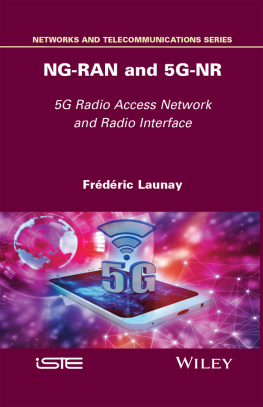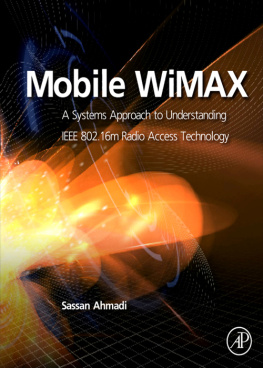GPRS for Mobile Internet
Emmanuel Seurre
Patrick Savelli
Pierre-Jean Pietri
Artech House
Boston * London www.artechhouse.com
Library of Congress Cataloging-in-Publication Data
Seurre, Emmanuel. GPRS for mobile Internet / Emmanuel Seurre, Patrick Savelli, Pierre-Jean Pietri. p. cm. (Artech House mobile communications series) Includes bibliographical references and index.
ISBN 1-58053-600-X (alk. paper)
1. Global system for mobile communications. 2. Wireless Internet-Standards. 3. Mobile communication systems-Standards. I. Savelli, Patrick. II. Pietri, Pierre-Jean. III. Title.
TK5103.483 .S48 2003
621.39'81-dc21 2002038272
British Library Cataloguing in Publication Data
Seurre, Emmanuel. GPRS for mobile Internet. - (Artech House mobile communications series)
1. Global system for mobile communications 2. General Packet Radio Service 3. Wireless Internet I. Title II. Savelli, Patrick III. Pietri, Pierre-Jean
621.3'845
ISBN 1-58053-600-X
Cover design by
Igor Valdman
Copyright 2003 ARTECH HOUSE
685 Canton Street
Norwood, MA 02062
All rights reserved. Printed and bound in the United States of America. No part of this book may be reproduced or utilized in any form or by any means, electronic or mechanical, including photocopying, recording, or by any information storage and retrieval system, without permission in writing from the publisher.
All terms mentioned in this book that are known to be trademarks or service marks have been appropriately capitalized. Artech House cannot attest to the accuracy of this information. Use of a term in this book should not be regarded as affecting the validity of any trademark or service mark.
International Standard Book Number: 1-58053-600-X
Library of Congress Catalog Card Number: 2002038272
10 9 8 7 6 5 4 3 2 1
Acknowledgments
We would like to thank the following persons for their support during the redaction phase, and for their relevant comments on the manuscript: Jacques Achard, Solofoniaina Razafindrahaba, Samuel Rousselin, Jean-Louis Guillet, and Dominique Cyne.
Emmanuel Seurre
Patrick Savelli
Pierre-Jean Pietri
France
December 2002
About the Authors
Emmanuel Seurre is a system engineer in Alcatel's handset division. He has worked on all of the GSM circuit data transmission technologies and has experience with all of the mobile layers related to GPRS and EDGE at the system and standards levels.
Patrick Savelli has acquired baseband and RF system expertise at the mobile phone divisions of Alcatel and Mitsubishi Electric, especially on GPRS, EDGE, and UMTS, for which he has followed the evolutions in the standards groups.
Pierre-Jean Pietri has worked for Alcatel, on a system specification team, and followed the standardization process for EDGE and GERAN for the BSS side. He now works for STMicroelectronics on the development of technical solutions for GSM/EDGE handsets.
Chapter 1: Introduction to the GSM System
This chapter provides an overview of the GSM cellular system, with a focus on the radio interface. The purpose is not to give a detailed description of the many features supported by the system, but to summarize the elementary concepts of GSM, as an aid to reader comprehension of the subsequent chapters. In-depth presentation of the GSM system can be found in [].
1.1 Introduction
1.1.1 Birth of the GSM System
The first step in the history of GSM development was achieved back in 1979, at the World Administrative Radio Conference, with the reservation of the 900-MHz band. In 1982 at the Conference of European Posts and Telegraphs (CEPT) in Stockholm, the Groupe Spcial Mobile was created, to implement a common mobile phone service in Europe on this 900-MHz frequency band. Currently the acronym GSM stands for Global System for Mobile Communication; the term "global" was preferred due to the intended adoption of this standard in every continent of the world.
The proposed system had to meet certain criteria, such as:
Good subjective speech quality (similar to the fixed network);
Affordability of handheld terminals and service;
Adaptability of handsets from country to country;
Support for wide range of new services;
Spectral efficiency improved with respect to the existing first-generation analog systems;
Compatibility with the fixed voice network and the data networks such as ISDN;
Security of transmissions.
Digital technology was chosen to ensure call quality.
The basic design of the system was set by 1987, after numerous discussions led to the choice of key elements such as the narrowband time-division multiple access (TDMA) scheme, or the modulation technique. In 1989 responsibility for the GSM was transferred to the European Telecommunication Standards Institute (ETSI). ETSI was asked by the EEC to unify European regulations in the telecommunications sector and in 1990 published phase I of the GSM system specifications (the phase 2 recommendations were published in 1995).
The first GSM handset prototypes were presented in Geneva for Telecom '91, where a GSM network was also set up. Commercial service had started by the end of 1991, and by 1993 there were 36 GSM networks in 22 countries. The system was standardized in Europe, but is now operational in more than 160 countries all over the world, and was adopted by 436 operators.
The growth of subscribers has been tremendous, reaching 500 million by May 2001.
1.1.2 The Standard Approach
The thousands of pages of GSM recommendations, designed by operators and infrastructure and mobile vendors, provide enough standardization to guarantee proper interworking between the components of the system. This is achieved by means of the functional and interface descriptions for each of the different entities.
The GSM today is still under improvement, with the definition of new features and evolution of existing features. This permanent evolution is reflected in the organization of the recommendations, first published as phase I, then phase II and phase II+, and now published with one release each year (releases 96, 97, 98, 99, and releases 4 and 5 in 2000 and 2001).
As stated, responsibility for the GSM specifications was carried by ETSI up to the end of 1999. During 2000, the responsibility of the GSM .
1.2 General Concepts
1.2.1 Analog Versus Digital Telephony Systems
First-generation systems were analog. During the early 1980s these systems underwent rapid development in Europe. Although the NMT system was used by all the Nordic countries, and the TACS system in the United Kingdom and Italy, there was a variety of systems and no compatibility among them. Compared with these systems, the main advantages offered by GSM, which is the most important of the second-generation digital systems, are:
Standardization;
Capacity;
Quality;
Security.
Standardization guarantees compatibility among systems of different countries, allowing subscribers to use their own terminals in those countries that have adopted the digital standard. The lack of standardization in the first-generation system limited service to within the borders of a country. Mobility is improved, since roaming is no longer limited to areas covered by a certain system (see ). Calls can be charged and handled using the same personal number even when the subscriber moves from one country to another.








